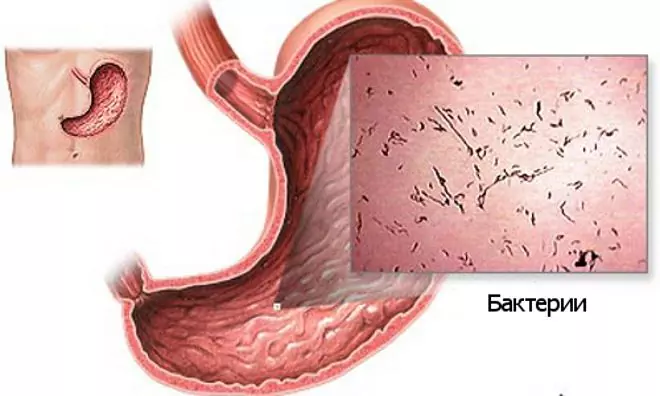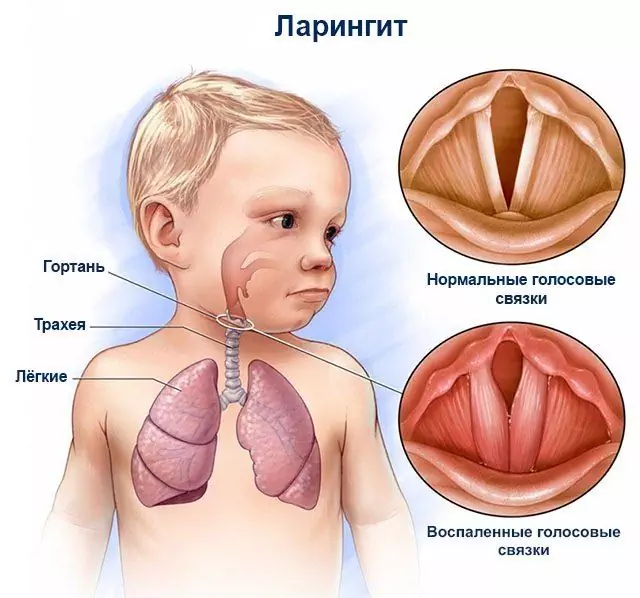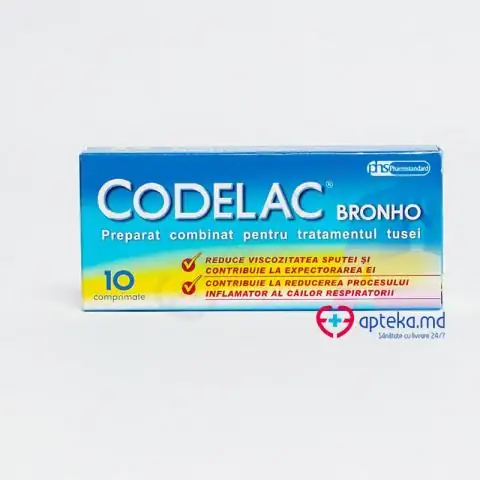- Author Rachel Wainwright [email protected].
- Public 2023-12-15 07:39.
- Last modified 2025-11-02 20:14.
Suprastinex
Suprastinex: instructions for use and reviews
- 1. Release form and composition
- 2. Pharmacological properties
- 3. Indications for use
- 4. Contraindications
- 5. Method of application and dosage
- 6. Side effects
- 7. Overdose
- 8. Special instructions
- 9. Application during pregnancy and lactation
- 10. Use in childhood
- 11. In case of impaired renal function
- 12. For violations of liver function
- 13. Use in the elderly
- 14. Drug interactions
- 15. Analogs
- 16. Terms and conditions of storage
- 17. Terms of dispensing from pharmacies
- 18. Reviews
- 19. Price in pharmacies
Latin name: Suprastinex
ATX code: R06AE09
Active ingredient: levocetirizine (levocetirizine)
Producer: EGIS Pharmaceuticals PLC (Hungary)
Description and photo update: 2018-23-10
Prices in pharmacies: from 218 rubles.
Buy

Suprastinex is an antiallergic drug, a blocker of histamine H 1 receptors.
Release form and composition
- film-coated tablets: almost white or white, biconvex, round, odorless or almost odorless; engraving “E” on one side, “281” on the other (7 pieces in a blister, in a cardboard box 1 or 2 blisters; 10 pieces in a blister, in a cardboard box 1, 2 or 3 blisters);
- drops for oral administration: almost colorless or colorless liquid with a slight odor of acetic acid, which does not form a precipitate (20 ml in a brown glass bottle equipped with a dropper, 1 bottle in a cardboard box).
Composition of 1 tablet Suprastinex:
- active substance: levocetirizine dihydrochloride - 5 mg (corresponds to levocetirizine in the amount of 4.21 mg);
- additional components: microcrystalline silicon cellulose Prosolv HD90 (microcrystalline cellulose - 98%, anhydrous colloidal silicon dioxide - 2%), low-substituted hyprolose (L-HPC11), lactose monohydrate, magnesium stearate;
- film shell: Opadry II 33G28523 white (triacetin - 6%, macrogol 3350 - 8%, lactose monohydrate - 21%, titanium dioxide - 25%, hypromellose 2910 - 40%).
Composition of 1 ml of Suprastinex drops:
- active substance: levocetirizine dihydrochloride - 5 mg;
- additional components: sodium acetate trihydrate, propylene glycol, methyl parahydroxybenzoate, glycerol (85%), sodium saccharinate, purified water, glacial acetic acid, propyl parahydroxybenzoate.
Pharmacological properties
Pharmacodynamics
Levocetirizine (active component of the drug) is an enantiomer of cetirizine, which is a member of the group of competitive histamine antagonists, which blocks H 1 -histamine receptors. The substance weakens the migration of eosinophils, reduces vascular permeability, inhibits the release of inflammatory mediators, and has an effect on the histamine-dependent stage of the development of allergic reactions.
Levocetirizine prevents and facilitates allergic reactions, has an anti-exudative and antipruritic effect. Almost does not show anticholinergic and antiserotonergic properties. When taking therapeutic doses, the drug practically does not show a sedative effect. The effect of Suprastinex begins to manifest itself 12 minutes after taking a single dose in 50% of patients, after 1 hour - in 95%, and lasts for 24 hours.
Pharmacokinetics
The pharmacokinetic parameters of levocetirizine are characterized by a linear relationship. After oral administration, the drug is rapidly absorbed from the gastrointestinal tract (GIT) in full. At the same time, food intake reduces the rate of absorption, but does not change its completeness. The bioavailability of the drug reaches 100%. After a single intake of a therapeutic single dose of the drug (5 mg) by adults, the maximum concentration (C max) in the blood plasma is observed after 0.9 hours and is 207 ng / ml for tablets, 270 ng / ml for drops, and after repeated administration of that the same dose reaches 308 ng / ml.
Levocetirizine has a high binding to blood plasma proteins - about 90%, the volume of distribution (V d) is 0.4 l / kg. Stationary concentration of the substance is reached after 48 hours.
Unlike other blockers of H 1 -histamine receptors, the metabolic transformation of which occurs in the liver using the cytochrome system, levocetirizine is metabolized in the body in small volumes (less than 14%) by N- and O-dealkylation, which results in the formation of a pharmacologically inactive metabolite. The interaction of the drug with other drugs is unlikely due to the lack of metabolic potential and insignificant metabolism.
The half-life (T ½) of Suprastinex in adults is 7.9 ± 1.9 hours (in the form of drops) and 7-10 hours (in the form of tablets), in young children T ½ is reduced. The total clearance in adults is 0.63 ml / min / kg, approximately 85.4% of the initial dose is excreted unchanged by the kidneys (through tubular secretion and glomerular filtration) and approximately 12.9% through the intestines.
In the presence of renal failure with a creatinine clearance (CC) value not exceeding 40 ml / min, the clearance of the agent decreases, and T ½ increases, in particular in patients on hemodialysis, there is a decrease in the total clearance by 80%, and a corresponding adjustment of the dosage regimen is required … Less than 10% of levocetirizine is removed during a standard 4-hour hemodialysis session.
Indications for use
According to the instructions, Suprastinex is recommended for the symptomatic treatment of the following diseases:
- seasonal (intermittent) and year-round (persistent) allergic conjunctivitis and rhinitis (conjunctival hyperemia, lacrimation, rhinorrhea, sneezing, itching);
- urticaria, including chronic idiopathic urticaria;
- hay fever (hay fever);
- allergic dermatoses, occurring with rashes and itching;
- Quincke's edema.
Contraindications
Absolute:
- glucose-galactose malabsorption syndrome, hereditary lactase deficiency, lactose intolerance (for tablets);
- pregnancy and lactation;
- age up to 6 years - for tablets, up to 2 years - for drops;
- end stage renal failure (CC <10 ml / min);
- hypersensitivity to any of the constituents of the drug, as well as piperazine derivatives.
Relative (it is necessary to use Suprastinex with extreme caution):
- chronic renal failure;
- elderly age;
- spinal cord injury, prostatic hyperplasia or other existing predisposing factors to urinary retention (since levocetirizine can exacerbate the threat of urinary retention);
- combined intake of ethanol.
Instructions for the use of Suprastinex: method and dosage
Both dosage forms of Suprastinex should be taken orally, on an empty stomach, or with food.
The tablets are swallowed whole, without breaking or chewing, with a little water. It is recommended to measure drops with a dropper in a teaspoon, 1 ml of the drug corresponds to 20 drops from a dropper. If necessary, immediately before taking the dose, the product can be diluted in a small amount of water.
The daily dose of tablets and drops in patients over 6 years old is intended for one dose.
The recommended daily dose of Suprastinex for children from 6 years of age and adults, including elderly patients with normal renal function, is 5 mg (1 tablet or 1 ml drops). The maximum allowable daily dose is 5 mg.
Suprastinex drops for children 2-6 years old are prescribed 2.5 mg of levocetirizine (0.5 ml, or 10 drops) per day, divided into 2 doses in equal doses of 1.25 mg, ie 0.25 ml (5 drops), while the maximum daily dose should not be higher than 2.5 mg.
The duration of drug treatment depends on the indications. In the treatment of persistent (year-round) allergic rhinitis with the onset of symptoms less than 4 days a week or with a total duration of less than 4 weeks, the course lasts until the symptoms are removed, in case of new symptoms, treatment can be resumed.
In the treatment of seasonal (intermittent) allergic rhinitis with the onset of symptoms more than 4 days a week or their total duration of more than 4 weeks, the drug is continued during the entire period of exposure to allergens.
The duration of therapy for pollinosis is determined by the attending physician individually and can vary on average from 1 to 6 weeks.
There is clinical experience of using Suprastinex for six months.
Due to the fact that levocetirizine is excreted by the kidneys, in renal failure and elderly patients, the dosage regimen must be adjusted taking into account the CC values. This indicator for men can be calculated using a special formula based on the concentration of serum creatinine: CC (ml / min) = [(140 - age in years) × body weight in kg] / 72 × serum CC value in mg / dl.
For women, the resulting value should be multiplied by a factor of 0.85.
The recommended frequency of taking a dose of 5 mg (1 tablet or 1 ml of drops), depending on the degree of renal failure (CC in ml / min):
- norm and mild degree (CC ≥ 50) - 1 time per day;
- medium degree (30 ≤ CC ≤ 49) - 1 time in 2 days;
- severe degree (10 ≤ CC ≤ 29) - 1 time in 3 days;
- terminal stage (CC <10) - reception is contraindicated.
In the presence of violations of only liver function, a change in the dosage regimen of Suprastinex is not required. In case of combined disorders of the liver and kidneys, it is recommended to correct the regimen according to the above recommendations.
Side effects
In the course of clinical studies in patients of both sexes aged 12-71 years, such disorders as fatigue, headache, dry mouth, drowsiness were often recorded; infrequently - abdominal pain, asthenia. In children 6-12 years old, the most common side effects of the drug were drowsiness and headache.
The undesirable effects that were noted during the period of post-registration use of Suprastinex included the following reactions (due to insufficient data, the frequency of development is unknown):
- cardiovascular system: tachycardia, palpitations, jugular vein thrombosis;
- hepatobiliary system: changes in liver function tests, hepatitis;
- digestive system: nausea, increased appetite, vomiting;
- nervous system: sinus thrombosis of the dura mater, dizziness, tremors, convulsions, paresthesia, dysgeusia, fainting;
- mental disorders: agitation, anxiety, insomnia, aggression, depression, hallucinations, suicidal thoughts;
- organs of hearing and vision: vertigo, blurred vision, visual impairment, inflammatory manifestations;
- respiratory system: worsening of rhinitis symptoms, shortness of breath;
- musculoskeletal system: muscle pain;
- allergic reactions: persistent drug erythema, photosensitivity, angioedema, urticaria;
- immune system: hypersensitivity reactions (including anaphylaxis);
- urinary system: urinary retention, dysuria;
- others: cross-reactivity, weight gain, peripheral edema;
- skin and soft tissues: itching, rash, cracks, hypotrichosis.
Overdose
Symptoms of an overdose of Suprastinex in adults may include drowsiness, in children - anxiety, agitation, alternating with drowsiness. If you suspect an overdose, if a little time has passed after taking an excessive dose, you should perform a gastric lavage or take activated charcoal, and then consult a doctor. Symptomatic and supportive treatment is recommended, there is no specific antidote, and hemodialysis is ineffective.
special instructions
It should be borne in mind that Suprastinex drops can cause the development of allergic reactions (sometimes late), since they include propyl parahydroxybenzoate and methyl parahydroxybenzoate in the composition.
It is recommended to refrain from drinking alcohol during treatment.
Influence on the ability to drive vehicles and complex mechanisms
Due to the fact that levocetirizine can cause the development of drowsiness, during the period of therapy with Suprastinex, it is recommended to refrain from driving a car and any other complex potentially dangerous mechanisms.
Application during pregnancy and lactation
According to the results of preclinical studies, intrauterine and neonatal toxic effects of levocetirizine and malformations accompanying drug therapy were not identified. No direct or indirect adverse effects on the course of pregnancy, childbirth and postnatal development were found either. However, due to the fact that adequate and strictly controlled clinical studies on the safety of using Suprastinex during pregnancy have not been conducted, its use is contraindicated in pregnant women.
Since levocetirizine passes into breast milk, if it is necessary to use it during lactation, breastfeeding should be discontinued.
Pediatric use
Taking Suprastinex tablets is contraindicated in children under 6 years old, drops - under 2 years old, due to the lack of sufficient clinical data indicating the effectiveness and safety of using the drug in patients of these age groups.
With impaired renal function
In the presence of renal failure, correction of the dosage regimen is required depending on the CC value. Suprastinex is contraindicated in patients with end-stage renal failure (CC below 10 ml / min).
For violations of liver function
In the presence of isolated liver dysfunction, dose adjustment is not required. For patients with combined functional disorders of the kidneys and liver, a change in the dosage regimen is recommended.
Use in the elderly
Elderly patients are advised to take Suprastinex with caution due to a possible decrease in glomerular filtration.
Drug interactions
The interaction of levocetirizine with other drugs has not been studied.
Interaction reactions that were established for cetirizine (since the pharmacokinetics of levocetirizine practically does not differ from the pharmacokinetics of cetirizine):
- ritonavir (at a dose of 600 mg 2 times a day) - when combined with cetirizine at a daily dose of 10 mg, there is an increase in cetirizine exposure by 40% and a decrease in ritonavir exposure by 10%;
- theophylline (in a daily dose of 400 mg) - there is a decrease in the total clearance of cetirizine by 16% (the kinetics of theophylline does not change);
- ketoconazole, pseudoephedrine, phenazone, cimetidine, azithromycin, erythromycin, diazepam, glipizide - no clinically significant undesirable interaction with the racemate cetirizine was detected.
There is no evidence that the racemate of cetirizine enhances the effect of ethanol, however, in some cases, with the combined use of levocetirizine with ethanol or other drugs that depress the central nervous system (CNS), the negative effect on the central nervous system may be aggravated.
Analogs
Analogues of Suprastinex are: Alerset-L, Zodak Express, Glenzet, Levocetirizine, Ksizal, Levocetirizin-Teva, Elset, Tsera, Levocetirizine Sandoz.
Terms and conditions of storage
Keep out of the reach of children, tablets - at temperatures below 30 ° C, drops - below 25 ° C, without freezing.
Shelf life of tablets - 5 years, drops - 4 years. Store the contents of the bottle after opening for no more than 6 weeks.
Terms of dispensing from pharmacies
Available without a prescription.
Reviews about Suprastinex
Reviews about Suprastinex are overwhelmingly positive. Patients who have taken the drug describe it as an effective remedy in the treatment of allergies, relieving its symptoms quickly and efficiently. According to reviews, the drug has also worked well as part of the complex therapy of infectious and inflammatory diseases accompanied by allergic manifestations.
The disadvantages of the drug include the development of side effects, mainly in the form of drowsiness and increased fatigue. Also, some patients express dissatisfaction with the price of the drug and the short shelf life of drops in an open bottle.
The price of Suprastinex in pharmacies
The price of Suprastinex depends on the form of release and can vary approximately within the following ranges:
- film-coated tablets: 7 pcs. in a package - from 230 to 290 rubles, 14 pcs. - from 400 to 500 rubles;
- drops for oral administration: 20 ml in a bottle - from 310 to 390 rubles.
Suprastinex: prices in online pharmacies
|
Drug name Price Pharmacy |
|
Suprastinex 5 mg film-coated tablets 7 pcs. RUB 218 Buy |
|
Suprastinex tablets p.p. 5mg 7 pcs. 234 r Buy |
|
Suprastinex 5 mg / ml drops for oral administration 20 ml 1 pc. 261 r Buy |
|
Suprastinex drops for internal approx. 5mg / ml 20ml RUB 291 Buy |
|
Suprastinex 5 mg film-coated tablets 14 pcs. 332 RUB Buy |
|
Suprastinex tablets p.p. 5mg 14 pcs. 457 r Buy |

Maria Kulkes Medical journalist About the author
Education: First Moscow State Medical University named after I. M. Sechenov, specialty "General Medicine".
Information about the drug is generalized, provided for informational purposes only and does not replace the official instructions. Self-medication is hazardous to health!






